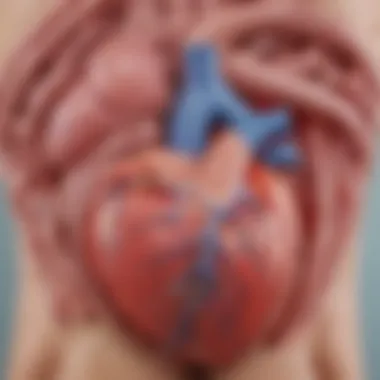Edema in Congestive Heart Failure: An In-Depth Analysis


Intro
Congestive heart failure (CHF) represents a complex syndrome that affects numerous individuals worldwide. Among the many challenges posed by this condition, edema is perhaps one of the most visible and troublesome manifestations. This fluid retention not only impacts patient comfort but also serves as a significant indicator of the underlying cardiac dysfunction. Understanding the intricacies of edema in the context of heart failure is critical for effective management and patient education.
This analysis delves into the mechanisms by which CHF induces edema, discussing the physiological changes that lead to increased fluid accumulation. Additionally, it examines the clinical implications of edema, various assessment methods utilized in practice, and contemporary management strategies that can be employed to provide relief for patients. The objective is to provide a multidimensional exploration of this pressing issue, aiming to bridge the gap between theoretical knowledge and practical application.
Key Concepts and Terminology
Definition of Key Terms
- Congestive Heart Failure (CHF): A condition in which the heart's ability to pump blood is compromised, leading to inadequate blood flow and fluid accumulation in the body.
- Edema: The medical term for swelling caused by excess fluid trapped in the body’s tissues.
- Fluid Retention: The accumulation of fluids in the body, often a symptom of underlying health issues such as heart failure.
Concepts Explored in the Article
The article explores several key concepts associated with edema in CHF:
- The pathophysiology of how heart failure contributes to fluid retention.
- The impact of edema on quality of life and clinical outcomes.
- Techniques for assessing the extent of edema and monitoring its progression.
- Best practices and strategies for managing edema in patients with CHF.
Findings and Discussion
Main Findings
Research indicates that edema in CHF patients is often a result of increased pressure in the blood vessels, leading to fluid leakage into surrounding tissues. This phenomenon can lead to various complications including reduced mobility and increased risk of infections.
Additionally, the assessment of edema can vary, using methods from visual inspection to advanced imaging techniques. Managing edema requires a holistic approach, which encompasses pharmacological interventions such as diuretics, dietary adjustments, and lifestyle modifications.
Potential Areas for Future Research
Future research could focus on:
- Innovative diuretic therapies to enhance fluid management in CHF patients.
- The role of patient education in self-management practices to alleviate edema.
- Longitudinal studies observing the impacts of edema on overall heart failure prognosis.
In summary, edema manifests as a significant issue for patients with congestive heart failure, warranting careful examination and tailored management strategies. The complexities surrounding fluid retention demand a comprehensive understanding to optimize healthcare outcomes.
Understanding Congestive Heart Failure
Congestive heart failure (CHF) is a critical condition that affects the cardiovascular system and has far-reaching implications for overall health. Understanding CHF is essential because it lays the foundation for comprehending the associated complications, such as edema. This section will detail the definition and classification of CHF, as well as its etiology and risk factors, revealing the complexities surrounding this medical issue.
Definition and Classification of CHF
Congestive heart failure is defined as the heart's inability to pump blood effectively to meet the body's needs. This insufficiency can lead to a variety of symptoms, including fatigue, shortness of breath, and swelling in the legs and abdomen, known as edema. CHF is generally classified into two major types: systolic and diastolic heart failure.
- Systolic heart failure occurs when the heart muscle weakens and cannot contract forcefully enough to maintain proper blood flow.
- Diastolic heart failure, on the other hand, happens when the heart's ventricles become stiff and cannot fill with blood adequately between beats.
Both types can coexist in a patient, known as mixed heart failure. Clinicians often use classifications based on functional capacity, such as the New York Heart Association (NYHA) classification, which stratifies heart failure into four classes depending on the severity of symptoms.
Understanding these classifications helps in tailoring appropriate treatments. It also sets the stage for discussing the role of edema, as its presence can vary depending on the type of heart failure.
Etiology and Risk Factors
The etiology of CHF is multifactorial. Common causes include coronary artery disease, hypertension, diabetes, and valvular heart disease.
Some of the primary risk factors that contribute to the development of CHF include:
- Age: The risk increases with age.
- Lifestyle: Factors such as smoking, obesity, and sedentary habits significantly raise the chances of heart failure.
- Family History: A genetic predisposition can influence an individual's risk.
- Comorbidities: Conditions like kidney dysfunction and sleep apnea can worsen heart failure symptoms.
Recognizing these factors is crucial for early diagnosis and intervention. Preventative measures, such as lifestyle changes and management of existing conditions, can effectively reduce the incidence or severity of CHF and its associated complications, such as edema.
What is Edema?
Edema is a significant clinical manifestation in patients with congestive heart failure (CHF). It refers to the accumulation of excess fluid in body tissues, often resulting in swelling. Understanding edema is essential because it directly affects patient comfort, mobility, and overall quality of life. Edema can be a clear indicator of the severity of heart failure, providing crucial insights into the patient's condition and also guiding treatment decisions.
Pathophysiology of Edema
The pathophysiology of edema in CHF stems primarily from imbalances in hydrostatic and oncotic pressures. When the heart can’t pump effectively, blood backs up, causing increased venous pressure. This rise in pressure forces fluid out of the capillaries into the surrounding tissues. Furthermore, reduced albumin levels, which is a protein crucial for maintaining oncotic pressure, can exacerbate fluid leakage. The interplay between these factors contributes to the development of edema, underlining the need for effective management strategies in CHF patients.


Types of Edema in CHF
Edema can manifest in various forms within CHF patients. Each type has its own implications and clinical significance.
Peripheral Edema
Peripheral edema is often visible in the legs and ankles, marking its presence with noticeable swelling. One key characteristic of peripheral edema is that it is usually more pronounced by the end of the day due to gravitational pooling of fluid. Its importance in this article lies in its direct impact on mobility and the patient’s ability to carry out daily activities. Peripheral edema can be managed through diuretics, but care must be taken to monitor fluid levels to avoid dehydration.
Pulmonary Edema
Pulmonary edema represents a more severe form of fluid accumulation that occurs in the lungs. The key characteristic of pulmonary edema is the difficulty in breathing it causes, which may lead to acute respiratory distress. This type of edema is critical for discussion in the context of CHF as it can be life-threatening. Treatment often requires hospitalization and intervention with diuretics and supplemental oxygen as necessary. The rapid development of pulmonary edema can indicate worsening heart function and necessitate immediate medical attention, highlighting its severity among the types of edema discussed in this analysis.
Cerebral Edema
Cerebral edema, although less common in CHF, can also occur, particularly in severe cases. This type of edema involves swelling in the brain, which can lead to neurological issues. The presence of cerebral edema is concerning; symptoms can include confusion, seizures, or loss of consciousness. As such, it is crucial to monitor for any neurological changes in CHF patients. Management often involves addressing the underlying causes and ensuring proper fluid management in heart failure treatment.
Edema in CHF is clearly multifaceted, impacting not only physical health but also influencing psychological and emotional well-being. The types of edema vary in their manifestations and treatment approaches, each requiring careful consideration in patient management.
Mechanisms Linking CHF and Edema
Understanding the mechanisms that link congestive heart failure (CHF) and edema is critical for both diagnosis and management. Edema management relies on comprehending the underlying physiological processes. These processes involve increased venous pressure, hormonal responses, and decreased cardiac output. Each mechanism contributes to fluid accumulation in tissues. Thus, a thorough analysis informs better clinical practices and patient education regarding associated complications.
Increased Venous Pressure
In CHF, the heart's inability to pump blood effectively leads to a build-up of pressure in the veins. This increased venous pressure results in fluid leakage from the bloodstream into surrounding tissues, a hallmark of edema. This fluid can accumulate in various locations, such as the legs, abdomen, and lungs. The significance of understanding this mechanism includes tailoring interventions that alleviate pressure. Reducing venous pressure can mitigate edema and improve patient outcomes.
Hormonal Responses
Hormonal regulation plays a vital role in fluid balance during CHF. Two major hormones involved are the renin-angiotensin-aldosterone system and natriuretic peptides. These systems reflect the body's efforts to compensate for low cardiac output and blood flow.
Renin-Angiotensin-Aldosterone System
The renin-angiotensin-aldosterone system, or RAAS, is crucial in fluid retention during CHF. This system responds to perceived low blood flow by releasing renin, which catalyzes angiotensin formation. Angiotensin constricts blood vessels and stimulates aldosterone secretion, leading to sodium and fluid retention. A key characteristic of RAAS is its role in regulating blood volume and pressure. This mechanism is beneficial to mention in this article as it directly correlates with why some patients experience significant fluid retention.
RAAS activation can produce advantages, such as short-term stabilization of blood pressure. However, chronic activation can be detrimental, leading to worsening edema and eventually contributing to adverse outcomes.
Natriuretic Peptides
Natriuretic peptides counteract the effects of the RAAS. They are released by the heart in response to increased pressure and volume overload. The key characteristic of natriuretic peptides is their ability to promote natriuresis, the excretion of sodium in urine. This mechanism assists in reducing fluid overload, making them an essential element in CHF management.
Natriuretic peptides are a popular focus in current research for their potential therapeutic benefits. They help to reduce excessive fluid retention and may serve as valuable markers for diagnosing heart failure severity. Despite their advantages, their effectiveness can vary among individuals due to differing responses in pathology.
Decreased Cardiac Output
Decreased cardiac output is another significant contributor to edema in CHF. When the heart cannot pump efficiently, blood is not adequately circulated, leading to reduced perfusion of tissues. This condition stimulates compensatory mechanisms like RAAS and leads to increased venous pressure. Moreover, decreased cardiac output also results in elevated hydrostatic pressure in capillaries, which exacerbates fluid leakage into interstitial spaces, creating a cycle that intensifies edema. Understanding this link is vital for addressing the root causes of fluid accumulation.
In summary, the mechanisms linking CHF and edema are complex but essential for managing this condition. By addressing increased venous pressure, hormonal responses, and the effects of decreased cardiac output, healthcare providers can strategize more effective treatment plans.
Clinical Assessment of Edema in CHF
The clinical assessment of edema in congestive heart failure (CHF) is critical in understanding the condition and shaping its management. Recognizing the signs and symptoms associated with edema helps clinicians make informed decisions regarding treatment and potential interventions. This aspect of care is important not only for accurate diagnosis but also for monitoring the disease progression and evaluating treatment efficacy. Accurate assessments allow for timely adjustments in management, ensuring the most effective strategies are employed to mitigate fluid retention and its associated complications.
Symptomatology
Symptoms of edema in CHF primarily include swelling in the lower extremities, abdominal discomfort due to ascites, or shortness of breath from pulmonary congestion. Such symptoms are valuable signals that reflect worsening fluid retention, often linked to compromised cardiac function. Understanding the patient's symptomatology can aid in distinguishing between fluid overload and other potential issues, ensuring appropriate interventions are implemented promptly. A detailed history of symptom onset, duration, and severity provides significant context for further evaluations.
Diagnostic Procedures
Effective diagnostic procedures are essential for confirming the presence and extent of edema in patients with CHF. Various methods can provide valuable insights regarding fluid accumulation and overall cardiac function. These procedures include physical examination, ultrasound imaging, and B-type Natriuretic Peptide testing.
Physical Examination
The physical examination is often the first step in evaluating edema in CHF. It involves assessing for signs of fluid retention, including swelling of the legs, abdomen, and other areas. Inspecting the skin and checking for pitting edema characterize this exam. The technique's accessibility makes it a practical initial assessment tool for healthcare providers.
Key Characteristic: The physical examination is beneficial due to its immediate nature; it can be performed during any patient interaction without requiring special equipment.


Unique Feature: The examination relies largely on the clinician's experience and observational skills, making it integral yet subjective.
Advantages and Disadvantages: While it provides quick insights, it may miss subtle changes in volume and cannot quantify the fluid's extent without additional tests.
Ultrasound Imaging
Ultrasound imaging offers a non-invasive method to assess edema by allowing visualization of fluid accumulation, particularly in the abdominal cavity or pericardium. This method can help determine the severity and potential underlying causes of edema.
Key Characteristic: Its real-time imaging capability supports immediate clinical decision-making, making it a popular choice for assessing organ involvement.
Unique Feature: Ultrasound can also guide other procedures, such as drainage of excess fluid, enhancing its utility in clinical practice.
Advantages and Disadvantages: It provides clear images of fluid levels; however, it may not always reveal cardiac function adequacy directly or address systemic circulation issues.
B-type Natriuretic Peptide Testing
B-type Natriuretic Peptide testing measures the levels of the peptide in the blood, which increases during heart failure due to ventricular stretch. Elevated levels indicate heart failure exacerbations and can correspond to the severity of edema.
Key Characteristic: It serves as a rapid and reliable laboratory test that complements clinical findings related to edema.
Unique Feature: The test aids in differentiating cardiac from non-cardiac causes of edema, which is vital for targeted treatment.
Advantages and Disadvantages: It is particularly beneficial in emergency settings; however, it may not fully capture all aspects of heart failure or provide insights into individual fluid status directly.
Management Strategies
The management strategies for edema in congestive heart failure (CHF) are critical for improving patient outcomes. Addressing edema effectively can impact quality of life and reduce the risk of complications. Strategies include both pharmacological and non-pharmacological approaches. Understanding these interventions helps clinicians tailor treatment to individual patient needs.
Pharmacological Approaches
Diuretics
Diuretics are the cornerstone of pharmacological treatment for edema in CHF. They promote the excretion of sodium and water through the kidneys, leading to a reduction in fluid retention. The key characteristic of diuretics is their ability to quickly alleviate symptoms of edema, providing rapid relief for patients. Furosemide, for example, is a commonly used loop diuretic that is effective in the management of severe edema.
The unique feature of diuretics lies in their dose-dependent efficacy. Higher doses can lead to greater fluid removal, but this comes with potential side effects such as dehydration and electrolyte imbalances. Hence, monitoring is essential to balance effectiveness with safety.
ACE Inhibitors
Angiotensin-converting enzyme (ACE) inhibitors also play an important role in managing edema associated with CHF. These drugs help to reduce the workload of the heart by promoting vasodilation and decreasing blood pressure. The key characteristic of ACE inhibitors is their ability to improve cardiac function while also reducing fluid retention. A commonly prescribed ACE inhibitor is lisinopril.
The unique feature of ACE inhibitors is their dual action—helping alleviate edema and improving heart efficiency. One of the advantages is the improvement in overall symptoms of heart failure. However, a disadvantage can be the risk of hyperkalemia and renal impairment, necessitating regular monitoring of kidney function.
Beta-Blockers
Beta-blockers are another important class of medication for managing CHF and consequently edema. They work by blocking the effects of adrenaline, leading to reduced heart rate and improved heart muscle function. The key characteristic of beta-blockers, such as carvedilol, is their utility in decreasing mortality associated with CHF.
The unique feature of beta-blockers is their role in negative chronotropic effects. These effects can improve symptoms associated with heart failure over time. However, some patients may experience side effects like fatigue or worsening heart failure symptoms initially. Monitoring is crucial when starting these agents.
Non-Pharmacological Interventions
Dietary Modifications
Dietary modifications play an essential role in managing edema in CHF. Reducing sodium intake is crucial, as high sodium levels can exacerbate fluid retention. The key characteristic of dietary changes is their long-term impact on fluid management and heart health. Patients are encouraged to read food labels and avoid processed foods, which often contain hidden salts.
The unique feature of dietary modifications is their potential to empower patients through self-management. Many individuals find that incorporating fresh fruits, vegetables, and whole grains positively affect their condition. This approach has its advantages, but strict adherence can be challenging. Therefore, the support of healthcare providers is often needed.
Fluid Management
Effective fluid management strategies are fundamental for patients with CHF. Appropriate fluid intake adjustments can limit congestion and edema. The key characteristic of fluid management includes tailoring fluid intake based on individual patient needs and output. Educating patients on the importance of fluid balance is crucial.
The unique feature of fluid management is the flexibility it offers in lifestyle. Patients can better understand their needs and adjust accordingly. However, excessive restriction might lead to dehydration in some cases, necessitating careful monitoring and adjustments by healthcare professionals.
Physical Activity Enhancements
Enhancing physical activity is vital in managing edema in CHF. Regular, moderate exercise can promote venous return and help manage fluid balance. The key characteristic of physical activity is its ability to improve cardiovascular fitness and reduce symptoms of heart failure.


The unique feature of physical activity enhancements is the promotion of overall well-being and independence. Engaging in light exercises based on individual capacity can provide long-term benefits. Yet, patients need guidance to ensure their exercise routines are safe and appropriate for their condition.
Challenges in Edema Management in CHF
The management of edema in congestive heart failure (CHF) presents multifaceted challenges that significantly influence patient outcomes. Understanding these challenges is crucial because effective management can mitigate the adverse effects of fluid retention, enhance quality of life, and ultimately improve prognosis.
Resistance to Diuretics
One of the primary obstacles in managing edema among CHF patients is resistance to diuretics. Diuretics, such as furosemide, are commonly employed to promote fluid excretion through the kidneys. In many patients, however, the desired diuretic effect may diminish over time. This phenomenon can occur for several reasons.
- Progression of Heart Failure: As CHF progresses, the kidneys can adapt to the presence of diuretics, leading to reduced responsiveness.
- Patient Factors: Kidney function, electrolyte levels, and concurrent medications can all impact how well a diuretic works.
- Noncompliance: Sometimes, patients may not take their medications as prescribed, unintentionally contributing to the ineffectiveness of treatment.
The result of diuretic resistance can be significant, as it may lead to worsening edema and increased hospitalization rates.
Patient Compliance Issues
Patient compliance is another critical issue in managing edema related to CHF. The complexity of treatment regimens can overwhelm patients. Some common compliance issues include:
- Multiple Medications: Patients often have to manage several medications, which can be confusing and lead to mistakes.
- Side Effects: Diuretics can have side effects such as dehydration, electrolyte imbalance, and fatigue, prompting patients to skip doses.
- Lifestyle Changes: Recommendations for dietary modifications and fluid restrictions may be difficult for patients to adhere to in everyday life.
"Effective management of edema in CHF requires a partnership between patients and healthcare providers, ensuring that patients understand their treatment plan and feel supported."
To address compliance issues, it is important to enhance patient education and support systems. Encouraging open communication and regular follow-ups can help tailor approaches that fit individual lifestyles and needs.
Emerging Research on Edema in CHF
The exploration of edema in congestive heart failure (CHF) is advancing steadily. Recent studies unveil new therapeutic avenues and molecular insights that significantly impact clinical practices. This section highlights emerging research in the field, emphasizing its relevance to improving patient outcomes.
Novel Therapeutic Options
Emerging therapeutic options are critical in reshaping how edema associated with CHF is managed. Current treatments like diuretics play a significant role, yet they often face limitations, especially in patients who develop diuretic resistance. Recent trials are examining agents such as SGLT2 inhibitors, which have shown promise not only in glycemic control for diabetic patients but also for their ability to reduce heart failure hospitalization rates and manage fluid retention. These agents offer a new way to handle edema effectively without amplifying renal stress, which is a common concern with traditional diuretics.
Another promising area is the development of drugs that can target the hormonal pathways involved in fluid regulation, particularly those related to the renin-angiotensin system. New drugs, including angiotensin receptor neprilysin inhibitors, present the dual action of preventing fluid overload while also benefiting cardiac function.
Genetic and Molecular Studies
The field of genetics is shedding light on the underlying mechanisms of edema in CHF. Studies investigating genetic predispositions are crucial for understanding why some patients suffer more severe fluid retention than others. Variations in genes related to sodium transport and fluid balance can affect how individuals respond to standard treatments, leading to tailored therapies that are more effective for specific patient profiles.
Additionally, molecular studies are focusing on biomarkers that can help assess the severity of edema and predict treatment responses. For instance, research into the levels of B-type natriuretic peptide (BNP) is ongoing, as this molecule has proven useful in evaluating heart failure intensity. By correlating these biomarker levels with changes in edema, clinicians can refine management strategies based on objective data.
"Understanding the genetic and molecular aspects of edema can lead us to personalized medicine approaches, improving outcomes for those suffering from CHF."
For further reading on related topics, you can explore resources like Wikipedia, Britannica, and specific heart failure communities on Reddit or Facebook.
Patient Education and Support
Patient education and support play a crucial role in the comprehensive management of edema related to congestive heart failure (CHF). Educating patients and their families helps them understand not only what edema is but also its significance in the context of heart failure. Patients who are well-informed are better equipped to manage their condition effectively, leading to improved quality of life and potentially better health outcomes.
Effective patient education entails explaining the mechanisms behind edema, its symptoms, and the reasons why it occurs in CHF. This understanding fosters a proactive approach to care, where patients can recognize early signs of worsening edema and take necessary actions, such as consulting their healthcare provider.
Moreover, the support elements of this education include addressing patient concerns and reinforcing the importance of adherence to prescribed medication and lifestyle changes. By creating a supportive environment, healthcare providers can encourage open dialogue. This way, patients can discuss challenges they face, particularly in relation to managing their fluid intake and understanding dietary restrictions.
Understanding Edema for Patients and Families
Educating patients and their families about edema involves discussing its definition, causes, and effects specifically in the context of CHF. Edema is generally defined as swelling caused by excess fluid accumulation in body tissues. For individuals with CHF, this swelling can be pronounced, particularly in the legs, ankles, and feet, but may also affect other areas like the abdomen.
It is essential for patients to recognize that edema can indicate worsening heart failure. Some common symptoms include:
- Swollen legs and feet.
- Rapid weight gain due to fluid retention.
- Shortness of breath.
- Abdominal discomfort.
Families must also be informed. They can help monitor symptoms and encourage patients to follow their treatment plans, including diet and medication compliance. Understanding edema enables families to provide valuable support, ensuring that they are aware of warning signs that should prompt medical attention.
Resources and Support Groups
Resources for patients and families dealing with CHF and edema are vital for effective management. Numerous organizations and online platforms offer comprehensive information and support. Some of these resources include:
- American Heart Association: This organization provides detailed guides about managing heart disease and related conditions including CHF. Their website contains useful educational materials.
- Heart Failure Society of America: They offer patient resources and support to improve understanding of heart failure and self-management strategies.
Support groups also serve an essential function. They create a community environment where patients and families can share experiences, challenges, and coping strategies. Through these groups, participants can gain insights from others facing similar situations. Online communities on platforms such as Reddit offer opportunities for individuals to engage and seek advice on managing edema in their day-to-day lives.
In summary, patient education about edema in CHF, complemented by accessible resources and support groups, aids in enhancing the understanding and management of this condition. This holistic approach allows both patients and their families to take an active role in health management, ultimately leading to improved outcomes.







